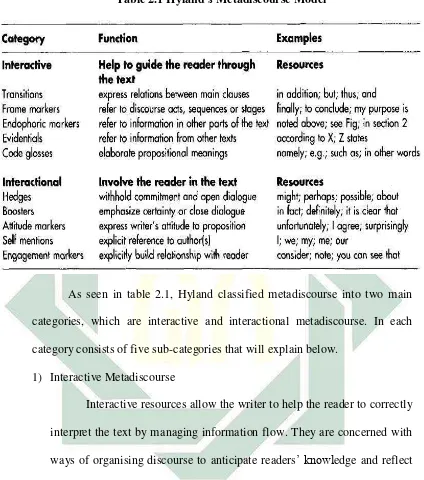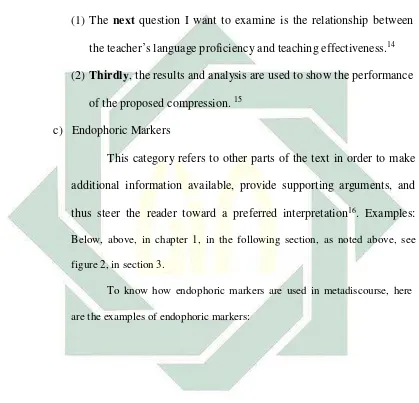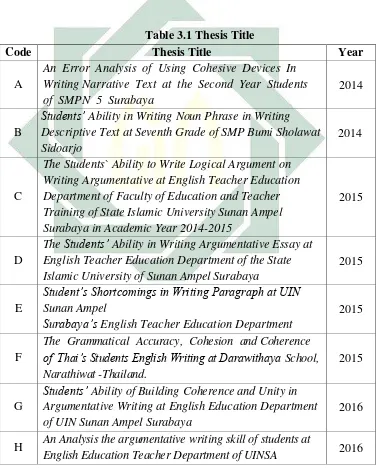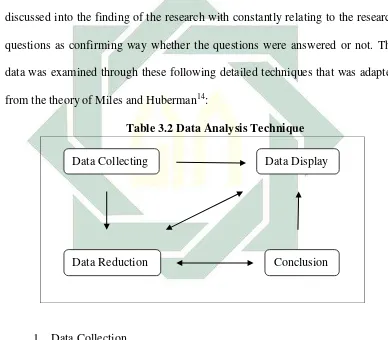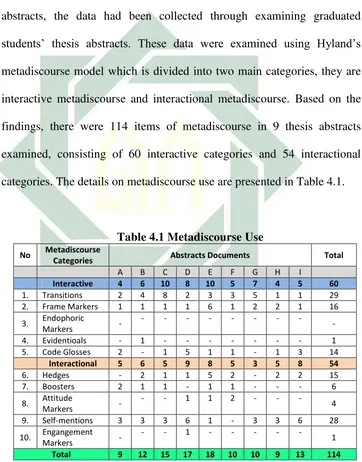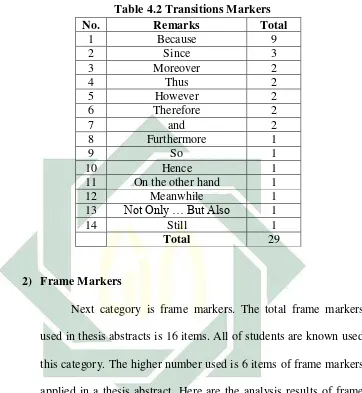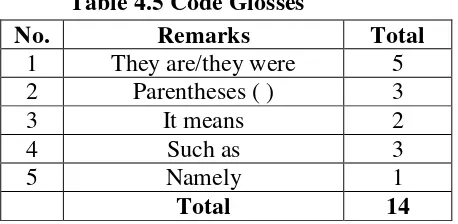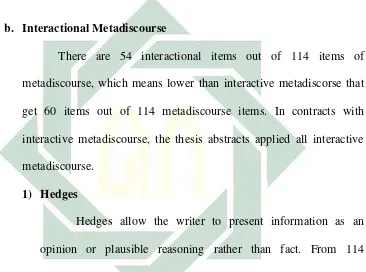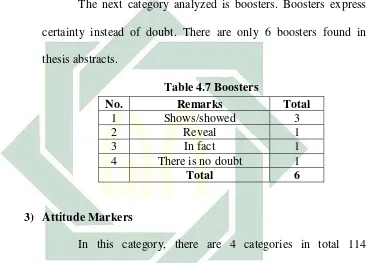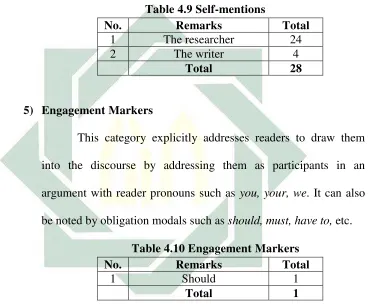THESIS
Submitted in partial fulfillment of the requirement for the degree of
Sarjana Pendidikan (S.Pd) in Teaching English
By
Nabalah Kayyisu Khusaini
NIM D05211037
ENGLISH TEACHER EDUCATION DEPARTMENT
FACULTY OF EDUCATION AND TEACHER TRAINING
STATE ISLAMIC UNIVERSITY OF SUNAN AMPEL
SURABAYA
digilib.uinsby.ac.id digilib.uinsby.ac.id digilib.uinsby.ac.id digilib.uinsby.ac.id digilib.uinsby.ac.id digilib.uinsby.ac.id digilib.uinsby.ac.id ix
ABSTRACT
Khusaini, Nabalah Kayyisu. (2017). Metadiscourse Categories of Thesis Abstracts at
English Teacher Education Department in UIN Sunan Ampel Surabaya. A
Thesis. English Teacher Education Department, Faculty of Education and Teacher Training, UIN SunanAmpel. Advisors: Rakhmawati, M. Pd. Key words: Thesis abstract, Metadiscourse, Metadiscourse Categories.
Since tells the summary of the entire paper, thesis abstract becomes crucial because readers always read it before reading the entire thesis. It may be a decider for readers whether they will probably continue reading the whole thesis or not. Therefore, thesis abstract need to persuade, and engage the readers. Meanwhile, abstract involves metadiscourse which associates the appropriate use of linguistic realization. It helps writers to organize the text so that writers can engage readers with their writing.The purpose of the study are to analyze the metadiscourse categories in thesis abstracts of English Teacher Education Department, to identify the metadiscourse categories that frequently appeared in thesis abstracts and its possible causes of frequently appeared. This study used qualitative as approach, and the research design is content or document analysis. The data was taken from thesis abstract of English Teacher Education Department Students year 2014-2016, with certain topic that was writing analysis and interview students whose thesis abstracts were examined. The available data was 9 thesis abstracts, and 6 graduated students interviewed. Metadiscourse
classification from Hyland’s theory was used for research instrument. Based on the result findings, the researcher found 114 metadiscourse items consisting of 60 interactive metadiscourse and 54 interactional metadiscourse. The use of metadiscourse in students’ thesis abstracts including 29 transitions, 16 frame markers, evidential, code glosses, hedges, boosters, attitude marker, self-mentions,
and engagement marker. The researcher also revealed metadiscourse categories that
digilib.uinsby.ac.id digilib.uinsby.ac.id digilib.uinsby.ac.id digilib.uinsby.ac.id digilib.uinsby.ac.id digilib.uinsby.ac.id digilib.uinsby.ac.id
E. Scope and the Limitation of The Study 9
F. Definition of Key Terms 10
2) Interactional Metadiscourse 19
3) Possible causes of frequent metadiscourse appeared 22
digilib.uinsby.ac.id digilib.uinsby.ac.id digilib.uinsby.ac.id digilib.uinsby.ac.id digilib.uinsby.ac.id digilib.uinsby.ac.id digilib.uinsby.ac.id xi
D. Data and Source Data 35
E. Research Instrument 36
F. Data Collection Technique 37
G. Data Analysis Technique 28
H. Checking Validity of Finding 42
CHAPTER IV RESEARCH FINDING
a. Research Finding 43
1. Metadiscourse Used inThesis Abstracts 44 2. Metadiscourse which Frequently Appeared 52 3. Possible Causes of Frequent Metadiscourse Appeared 53
b. Discussion 58
4) Metadiscourse Used inThesis Abstracts 58 5) Metadiscourse which Frequently Appeared 69 6) Possible Causes of Frequent Metadiscourse Appeared 70
CHAPTER V CONCLUSION AND SUGGESTION
A. Conclusion 73
B. Suggestion 74
REFERENCES
digilib.uinsby.ac.id digilib.uinsby.ac.id digilib.uinsby.ac.id digilib.uinsby.ac.id digilib.uinsby.ac.id digilib.uinsby.ac.id digilib.uinsby.ac.id
72
CHAPTER I
INTRODUCTION
This chapter discusses the area of the study that will be covered in some headings of background, Research Question, Objectives of the Study, Significance of the Study, Scope and Limitation of the Study, Definition of Key Terms.
A. Research Background
Writing activities play a crucial role in students’ learning process. They
start writing from the early up to the late stage, e.g., writing paragraph, writing summary, research proposal, etc. Besides, as an important academic activity, writing imposes great challenge for writers, especially for novice student writers. The challenge is even higher when students write in English as a foreign language, as they not only have to appropriate themselves to the disciplinary discourse but also to do it in a language whose the rhetorical is quite different from their mother tongue. Therefore, Geiser and Studly cited by McNamara, et.al stated that for students, writing ability is among the best predictors for success in course work during their years of study.1
As Rao in Rutipa explained that EFL writing is useful in two respects, i.e.,
it encourages students’ thinking, organizing ideas, developing their abilities to
1 McNamara, D. S., Crossley, S. A., & McCarthy, P. M. Linguistic Categories of Writing Quality .
digilib.uinsby.ac.id digilib.uinsby.ac.id digilib.uinsby.ac.id digilib.uinsby.ac.id digilib.uinsby.ac.id digilib.uinsby.ac.id digilib.uinsby.ac.id
summarize, analyze, and criticize. And it strengthens their learning and thinking. 2
University students, in this case undergraduate students have a lot of projects regarding to writing activity as they are expected to develop their critical thinking through writing. To culminate the title degree based on their discipline, university students should to do research paper known as thesis which this activity dealing with writing.
Based on Writing Thesis Guidance Book year 2014 in English Teacher Education Department Sunan Ampel State Islamic University, there are three parts of thesis, they are beggining part involves thesis title, approval sheet, dedication sheet, acknowledgment, abstract, table of content, list of tables, list of graphics/pictures, list of appendices. Content part involves introduction, review of related literature, research method, result and discussion, conclusion and suggestion. Then, the last part includes references and appendices.3
Since tells the summary of the entire paper, abstract becomes crucial because readers always read it before reading the entire paper. It is not only the means to inform about the content of a research study, but also a vehicle for arousing the curiosity and interest of the reader. As Hyland in Al-Shujairi, et.al.
argued that the abstract is generally also the readers’ first encounter with text,
and it is often the point at which they decide whether to continue and give the
2
Kathrina Rustipa. Metadis ourse i I do esia EFL Lear ers’ Persuasi e Te ts: A Case “tud at
E glish Depart e t, UNI“BANK .International Journal of English Linguistics; Vol. 4, No. 1, 2014, 44
3 Prof. Dr. H. Ali Mudlofir, M.Ag, et.al., Pedoman Teknik Penulisan Skripsi, (Surabaya:UIN Sunan
digilib.uinsby.ac.id digilib.uinsby.ac.id digilib.uinsby.ac.id digilib.uinsby.ac.id digilib.uinsby.ac.id digilib.uinsby.ac.id digilib.uinsby.ac.id
accompanying article further attention or to ignore it.4 According to Wallwork, first impression is very important because it will represent the whole of something5. In research paper case, first impression will be represented by abstract. Through abstract, reader can expect the quality of the research and decide whether the article is worth the reading or not.
Abstracts help readers who are going to read the whole article, by offering an overview of the research, thus saving their time. In cases where readers are uncertain from the title whether the paper contains material of interest to them, the abstract help them by informing them more precisely of what the article covers. Thus, the writer should be careful in the way they write the abstract and the appropriate linguistics categories need to be used.
Abstract involves metadiscourse which associates the appropriate use of linguistic realization.6 It represents what the writer attempts to guide the reader’s perception of a text. Because abstract function as “advertising means” to bring the attention the the reader to read the whole research paper, metadiscourse is needed to help writers organize their texts, and engange readers. It is the set of linguistic resources that every language has as part of the textual metafunction for linking one part of a text to another.
4
Yasir Bdaiwi Jasim Al-Shujairi, et.al., Role of Moves, Tenses, and Metadiscourse in the Abstract of
an Acceptable Research Article , Mediterranean Journal of Social Sciences. Vol. 7 no. 2, March 2016,
379. 5
Adrian Wallwork, English for Writing Research Paper, (London:Spriger, 2011), 177.
6 Yasir Bdaiwi Jasim Al-Shujairi, et.al., Role of Moves, Tenses, and Metadiscourse in the Abstract of
digilib.uinsby.ac.id digilib.uinsby.ac.id digilib.uinsby.ac.id digilib.uinsby.ac.id digilib.uinsby.ac.id digilib.uinsby.ac.id digilib.uinsby.ac.id
As Hyland and Tse pointed out three key priciples of metadiscourse, they are; Metadiscourse is distinct from propositional aspects of discourse; Metadiscourse refers to aspects of the text that embody writer-reader interactions; Metadiscourse refers only to relations which are internal to the discourse.7
Hyland also asserted the concept of metadiscourse is based on a view of writing (and speaking) as a social and communicative engagement, offering a means of understanding the ways we project ourselves into our texts to manage our communicative intentions.8 Metadiscourse itself is discourse about discourse or writing about writing. It is a discourse which has a writer-reader interaction in text. Metadiscourse is self-reflective linguistic expressions referring to the evolving text, to the writer, and to the imagined readers of that text.9
Cheng in Shi and Han argued that all writing is motivated by the intention to persuade-to convince our readers to take certain actions, to adopt our world view, to agree with us and like us.10 A writer wants a message to be understood and to be accepted. There is always more than one plausible interpretation for a given piece of data and readers always retain the option of rejecting the writer's message. Metadiscourse is one indication of a writer's response to the potential
7
Ke H la d, Poll Tse, Metadis ourse i A ade i Writi g , Applied Linguistic, 25(2), 2004, 159. 8
Ken Hyland. Metadiscourse: Exploring interaction in writing. (London:Continiuum, 2005), 14.
9Ke H la d,
Disciplinary interactions: metadiscourse in L2 postgraduate writing”, Journal of Second
Language Writing 13, 2004, 133.
10 Weixuan Shi & Jikun Han. Research on Writing Samples from the Perspective of Metadiscourse .
digilib.uinsby.ac.id digilib.uinsby.ac.id digilib.uinsby.ac.id digilib.uinsby.ac.id digilib.uinsby.ac.id digilib.uinsby.ac.id digilib.uinsby.ac.id
negatability of his claims, an intervention to engage the reader and anticipate possible objections or difficulties of interpretation. The use of metadiscourse shows the writer's "friendly" attitude to the reader and provides coherent and related ideas from one to another.
Due to diverse meanings of metadiscourse categories, there are several categories for these markers in the literature. The popular models are from Vande Kopple, Crismore and Hyland. In this research, metadiscourse model from Hyland is used as means for analyzing the metadiscourse categories in thesis abstracts. Hyland classified metadiscourse in two categories, they are interactive metadiscourse and interactional metadiscourse.
There are several previous study related to this study, The first is Representation of Rhetorical Move of Thesis Abstracts in English Teacher
Education Departement by Lathifatul Fajriyah11. In this study, Fajriyah analyzed
the move structure in 22 thesis abstracts of undergrduate students in English Teacher Education Department. She found out the rhetorical moves of thesis abstracts and differences moves among thesis abstracts of English Teacher Education Department.
Even her study and this study analyze the similar data, however, this study tries to examine difference aspect in thesis abstracts. Her study examines its
11 Lathifatul Fajriyah,
digilib.uinsby.ac.id digilib.uinsby.ac.id digilib.uinsby.ac.id digilib.uinsby.ac.id digilib.uinsby.ac.id digilib.uinsby.ac.id digilib.uinsby.ac.id
rhetorical moves in abstracts, while this study examines its metadiscourse categories.
The second is study conducted by Mirshamsi and Allami entitled Metadiscourse Markers in the Discussion/Conclusion Section of Persian and
English Master's Theses12. In Mirshami and Allami study, they observed about
interactive and interactional metadiscourse markers used in discussion and
conclusion sections of master’ theses. They tried to find out the similarities and
differences in the use of metadiscourse markers in three categories, they are native English speakers, native Persian speakers, and non-native English speakers. And the result showed that native English writers used more interactive and interactional metadiscourse markers than native Persian and EFL learners.
In sum, since it contains a brief of a research paper, abstract might be the first thing that readers seek before reading the whole paper. Therefore, writers have to notice the appropriate linguistics categories need to be used in order to persuade and convince readers to continue read the next section after abstract. In this case, writer should pay attention to metadiscourse categories which associates the appropriate use of linguistic realization. It is beneficial for writers knowing these categories as it is recognized as an essential means of facilitating communication. For one thing, it helps the writer produces the
12 A.Mirsha si, H.Alla i, Metadiscourse Markers in the Discussion/Conclusion Section of Persian
digilib.uinsby.ac.id digilib.uinsby.ac.id digilib.uinsby.ac.id digilib.uinsby.ac.id digilib.uinsby.ac.id digilib.uinsby.ac.id digilib.uinsby.ac.id
discourse. For another, it helps the reader understand the primary message and
the author’s attitude toward the content of the discourse.
Considering the reasons stated previously, the researcher tries to analyze the metadiscourse categories applied in undergraduate thesis abstracts of English Teacher Education Department students with certain topic, which is writing analysis using metadiscourse model from Hyland. Categories of metadiscourse
which adopted from Hyland’s metadiscourse model are used as the means to
analysis thesis abstracts.
The researcher used Hyland’ theory because it is seen as potentially
useful as it effectively characterizes the need of writers to write a good academic argument since this study examines thesis abstracts which needs arguments to engage and convince the readers to continue reading the whole thesis. Besides,
Hyland’s model of metadiscourse is based on the research in academic discourse,
which made the model more concrete and more influential. It helps to more clearly identify metadiscourse functions by eliminating formal categories and minimizing functional overlap. Because this study focuses on metadiscourse in written, the researcher decides to choose writing analysis as an abstract’s topic.
digilib.uinsby.ac.id digilib.uinsby.ac.id digilib.uinsby.ac.id digilib.uinsby.ac.id digilib.uinsby.ac.id digilib.uinsby.ac.id digilib.uinsby.ac.id B. Research Question
Based on the background stated previously, this study is intended to questions:
1.What are the metadiscourse categories used in thesis abstracts at English Teacher Education Department of UIN Sunan Ampel Surabaya?
2.What are the metadiscourse categories that commonly appeared in thesis abstracts at English Teacher Education Department of UIN Sunan Ampel Surabaya?
3.What are possible causes of the metadiscourse categories that commonly appeared in thesis abstracts at English Teacher Education Department of UIN Sunan Ampel Surabaya?
C. Objectives of the Research
Considering the statement of the problem questioned on this study, the aim of this study are:
1.To analyze the metadiscourse categories applied in thesis abstract at English Teacher Education Department of UIN Sunan Ampel Surabaya.
digilib.uinsby.ac.id digilib.uinsby.ac.id digilib.uinsby.ac.id digilib.uinsby.ac.id digilib.uinsby.ac.id digilib.uinsby.ac.id digilib.uinsby.ac.id
3.To find out the possible causes of the metadiscourse categories which is commonly appeared in thesis abstracts at English Teacher Education Department of UIN Sunan Ampel Surabaya.
D. Significance of the Research
This study attempts to give both theoritical and practical contribution: 1. Theoritically
a. This study is intended to contribute research on analysis of metadiscourse in writing skill.
b. The result of this research can be useful as the reference for next researcher who wants to conduct a research on the same or similar topic as in this research.
2. Practically
a. For Learners
This research shows the learners the use of metadiscourse, especially in writing skills. And how to write the appropriate abstracts for university students. In this case, undergraduate students.
b. For Teachers
digilib.uinsby.ac.id digilib.uinsby.ac.id digilib.uinsby.ac.id digilib.uinsby.ac.id digilib.uinsby.ac.id digilib.uinsby.ac.id digilib.uinsby.ac.id
engage the readers, also help the writer to organize the text. In this case, thesis abstract.
E. Scope and Limitation of the Research
This study only focuses on thesis abstracts written in English. The abstracts are written by English Teacher Education Department’ students who were graduated in between 2014 and 2016 in UIN Sunan Ampel Surabaya. Thus, writing related to analysis is the topic chosen of thesis abstracts since this study analyzes metadiscourse in text which is similar to the topic. Specific study that is analyzed in this study is metadiscourse categories which appears in thesis abstracts. And the metadiscourse categories are adopted from Hyland’s model of metadiscourse.
F. Defintion of Key Terms
1. Metadiscourse :
According to Hyland metadiscourse embodies the idea that communication is more than just the exchange of information, goods or services, but also involves the personalities, attitudes and assumptions of those who are communicating.13 In this study, metadiscourse is the way writers use words or phrases to organize the texts and engage readers.
13
digilib.uinsby.ac.id digilib.uinsby.ac.id digilib.uinsby.ac.id digilib.uinsby.ac.id digilib.uinsby.ac.id digilib.uinsby.ac.id digilib.uinsby.ac.id
2. Metadiscourse Categories :
The researcher uses Hyland’s model of metadiscourse to define metadiscourse categories in this study. His model comprised of two main categories (Interactive and Interactional Metadiscourse) and five sub-categories in each main category (Interactive: transitions, frame markers,
endophoric markers, evidentials, and code glosses; Interactional: hedges,
boosters, attitude markers, self-mentions, and engagement markers)14
3. Abstract :
Abstract is the summary of a research article that is written in the beginning of an academic paper. Its main purpose is to help other researchers and readers make a decision in selecting the readings.15 In this research, abstract defines as a brief or summary of thesis written by English Teacher
Education Department’ students of Sunan Ampel State Islamic University.
14
Ken Hyland. Metadiscourse: Exploring interaction in writing. ……….., 49.
15Ali Moha adi Dara ad, Move Analysis of Research Article Abstracts: A Cross-Disciplinary Study .
digilib.uinsby.ac.id digilib.uinsby.ac.id digilib.uinsby.ac.id digilib.uinsby.ac.id digilib.uinsby.ac.id digilib.uinsby.ac.id digilib.uinsby.ac.id
CHAPTER II
REVIEW OF RELATED LITERATURE
This chapter give a brief explaination about theories that support this study. There are two sub-section in this chapter, the review of related literature and the previous studies regarding with the analysis of metadisccourse in thesis abstracts.
A. Review of Related Literature
1. Definition of Metadiscourse
The term metadiscourse was coined by Zellig Harris in 1960 to offer a way of understanding language in use, representing a writer's or speaker's attempts to guide a receiver's perception of a text. The concept has been further developed by writers such as Williams, Vande Kopple, Crismore, and Hyland.1
Metadiscourse is self-reflective linguistic expressions referring to the evolving text, to the writer, and to the imagined readers of that text.2 Hyland in Shin and Han stated that metadiscourse connects discourse and context together.3 He highlights the interpersonal function of metadiscourse. In short,
1 1 Ken Hyland. Metadiscourse: Exploring interaction in writing. (London:Continiuum, 2005), 3 2 Ken Hyland, Disciplinary interactions: metadiscourse in L2 postgraduate writing”, Journal of Second
Language Writing 13, 2004, 133.
3 Weixuan Shi & Jikun Han. Research on Writing Samples from the Perspective of Metadiscourse .
English Language Teaching, Vol. 7, No. 11, 2014, 152.
digilib.uinsby.ac.id digilib.uinsby.ac.id digilib.uinsby.ac.id digilib.uinsby.ac.id digilib.uinsby.ac.id digilib.uinsby.ac.id digilib.uinsby.ac.id
metadiscourse is recognized as an essential means of facilitating communication. For one thing, it helps the writer to produce the discourse. For another, it helps the reader understand the primary message and the author’s attitude toward the content of the discourse. So, metadiscourse is like glue that holds sentences and paragraphs together.
Hyland and Tse explain that all metadiscourse is interpersonal because it takes account of the reader’s knowledge, textual experiences, and processing needs and that it provides writers with an armory of rhetorical appeals to achieve this.4 The notion of the writer-reader interactions has underpinnings on the following three key principles of metadiscourse that was suggested by Hyland &Tse:
a. Metadiscourse is distinct from propositional aspects of discourse. b. Metadiscourse refers to aspects of the text that embody writer-
reader interactions.
c. Metadiscourse refers to relations only that are internal to the discourse.5
Hyland’s model of metadiscourse comprised of two main categories of interactive and interactional metadiscourse. The interactive part of metadiscourse concerns the writer’s awareness of his receiver, and his attempts to accommodate his interests and needs, and to make the argument
digilib.uinsby.ac.id digilib.uinsby.ac.id digilib.uinsby.ac.id digilib.uinsby.ac.id digilib.uinsby.ac.id digilib.uinsby.ac.id digilib.uinsby.ac.id
satisfactory for him. In this part there are five sub-categories, those are, transition, frame markers, endhoporic markers, evidential and code glosse.
The interactional part, on the other hand, concerns the writer’s attempts to make his views explicit, and to engage the reader by anticipating his objections and responses to the text. The sub-categories for interactional part of metadiscourse are hedges, boosters, attitude markers, self-mentions, and
engagement markers.6
2. Metadiscourse Categories
Metadiscorse category is the categories of metadiscourse. Hyland’s model of metadiscourse is used in this study to define the metadiscourse categories. This study uses Hyland’s model because his metadiscourse model is based on the research in academic discourse, which makes the model more concrete and more influential. It is also noted by Abdi, Hyland’s model is highly preferred in modern metadiscourse studies for being recent, simple,
clear and comprehensive.7
6 Ken Hyland. Metadiscourse: Exploring interaction in writing. (London:Continiuum, 2005), 49. 7 R. Abdi. (2011). Metadiscourse Strategies in Research Articles: A Study of the Differences across
digilib.uinsby.ac.id digilib.uinsby.ac.id digilib.uinsby.ac.id digilib.uinsby.ac.id digilib.uinsby.ac.id digilib.uinsby.ac.id digilib.uinsby.ac.id Table 2.1 Hyland’s Metadiscourse Model
As seen in table 2.1, Hyland classified metadiscourse into two main categories, which are interactive and interactional metadiscourse. In each category consists of five sub-categories that will explain below.
1) Interactive Metadiscourse
Interactive resources allow the writer to help the reader to correctly interpret the text by managing information flow. They are concerned with ways of organising discourse to anticipate readers’ knowledge and reflect the writer’s assessment of what needs to be made explicit to constrain and
guide what can be recovered from the text.8
8 Ken Hyland, Disciplinary interactions: metadiscourse in L2 postgraduate writing”, Journal of Second
digilib.uinsby.ac.id digilib.uinsby.ac.id digilib.uinsby.ac.id digilib.uinsby.ac.id digilib.uinsby.ac.id digilib.uinsby.ac.id digilib.uinsby.ac.id
a) Transition
Transitions are logical connectors that express semantic relation between main clauses or sentences. They are realized mainly with conjunctions used to mark additive, contrastive, consequential, temporal.9 But, to count as metadiscourse they must perform a role
internal to the discourse rather than the outside world, helping the reader interpret links between ideas.10 Examples: In addition, but, thus, and, moreover, furthermore, therefore, on the other hand.
Here are the examples of transition in metadiscourse:
(1) In contrast, these findings were not found among the low collectivists.11
(2) 93 questionnaires were received with 84 valid responses.
Therefore the response rate for the questionnaire is 37 percent.12 b) Frame Markers
Frame markers, is used primarily to organize texts for readers. Frame markers are a cover term for a variety of linguistic devices and can be further classified into four subtypes according to their
9 Kathrina Rustipa. Metadiscourse in Indonesian EFL Learners’ Persuasive Texts: A Case Study at
English Department, UNISBANK .International Journal of English Linguistics; Vol. 4, No. 1, 2014, p.46
digilib.uinsby.ac.id digilib.uinsby.ac.id digilib.uinsby.ac.id digilib.uinsby.ac.id digilib.uinsby.ac.id digilib.uinsby.ac.id digilib.uinsby.ac.id
functions: sequencers, topicalizers, discourse-labels, and announcers.13 Examples: Finally, my purpose, firstly, to sum up, in short, return to, in regard to, aim.
The following sentences are examples of frame markers: (1) The next question I want to examine is the relationship between
the teacher’s language proficiency and teaching effectiveness.14
(2) Thirdly, the results and analysis are used to show the performance of the proposed compression. 15
c) Endophoric Markers
This category refers to other parts of the text in order to make additional information available, provide supporting arguments, and thus steer the reader toward a preferred interpretation16. Examples:
Below, above, in chapter 1, in the following section, as noted above, see
figure 2, in section 3.
To know how endophoric markers are used in metadiscourse, here
are the examples of endophoric markers:
13 Feng Cao, Guangwei Hu, Interactive metadiscourse in research articles: A comparative study of
paradigmatic and disciplinary influences , Journal of Pragmatics 66, 15—31, 2014. P.19
14 Ken Hyland, Disciplinary interactions: metadiscourse in L2 postgraduate writing”, Journal of
Second Language Writing 13, 2004, p.141
15 Ken Hyland, Polly Tse, Metadiscourse in Academic Writing , ………. P. 166
16 Malcolm William, Translating Metadiscourse: An Explanatory Analysis of Problems in Students’
digilib.uinsby.ac.id digilib.uinsby.ac.id digilib.uinsby.ac.id digilib.uinsby.ac.id digilib.uinsby.ac.id digilib.uinsby.ac.id digilib.uinsby.ac.id (1) This article has brought a micro-interactional perspective to bear on a
perennial problem in school reform policy and research.17
(2) Revenue from sale of bottles as computed above.18
d) Evidential
Evidentials refer to information from other. In academic discourse, evidential markers typically take the form of citations or academic attributions.19 Examples: According to Z, X states, cited, in
Y’s study.
(1) According to Slobin, ‘‘children are guided by the set of grammaticalized distinctions in the language to attend to such categories of events while speaking’’
(2) In an insightful reflection on human identity, Taylor (1989) wrote, ‘‘Our identity is what allows us to define what is important to us and what is not’’20
e) Code Glosses
It supplies additional information, by rephrasing, explaining or elaborating what has been said, to ensure the reader is able to recover
17 Feng Cao, Guangwei Hu, Interactive metadiscourse in research articles: A comparative study of
paradigmatic and disciplinary influences , ……… P.24
18 Hesham Suleiman Alyousef, An Investigation of Metadiscourse Categories in International
Postgraduate Business Students’ Texts: The Use of Interactive and Interactional Markers in Tertiary Multimodal Finance Texts , SAGE Open October-December: 1–10. 2015, .p.7
19 Feng Cao, Guangwei Hu, Interactive metadiscourse in research articles: ………..
……… P.19
digilib.uinsby.ac.id digilib.uinsby.ac.id digilib.uinsby.ac.id digilib.uinsby.ac.id digilib.uinsby.ac.id digilib.uinsby.ac.id digilib.uinsby.ac.id
the writer's intended meaning.21 Examples: Called, defined as, e.g., in other words, specifically, for instance, namely, such as.
(1) Other individual-level covariates include race/ethnicity (white, black, Hispanic, other), education (less than high school, high school graduate, college graduate) ……..22
(2) ……. it would be possible to see and understand how the cultural resources of the group—e.g., adherence to the class’ norms of behavior, the particular language of the classroom, and the
relationships built on respect and responsibility—would be ….23
2) Interactional Metadiscourse
Interactional resources focus on the participants of the interaction and seek to display the writer’s persona and a tenor consistent with the
norms of the disciplinary community. Metadiscourse here concerns the writer’s efforts to control the level of personality in a text and establish a suitable relationship to his or her data, arguments, and audience, marking the degree of intimacy, the expression of attitude, the communication of
commitments, and the extent of reader involvement.24
21 Ken Hyland. Metadiscourse: Exploring interaction in writing. (London:Continiuum, 2005), p.52 22 Abdi, et al., The cooperative principle in discourse communities and genres: A framework for the
use of metadiscourse. , Journal of Pragmatics 42, 1669–1679, 2010, p. 1674
23 Abdi, et al., The cooperative principle in discourse communities and genres: A framework for the
use of metadiscourse. , Journal of Pragmatics 42, ...p. 1674
digilib.uinsby.ac.id digilib.uinsby.ac.id digilib.uinsby.ac.id digilib.uinsby.ac.id digilib.uinsby.ac.id digilib.uinsby.ac.id digilib.uinsby.ac.id
a) Hedges
Hedges are resources that writers use to recognize alternative voices and viewpoints and so withhold commitment to the proposition. According to Hyland hedges allow the writer to present information as an opinion or a plausible reasoning rather than a fact.25 Example: May, possible, perhaps, about, in my opinion, from my perspective.
These examples are sentences containing hedges:
(1) It is possible that the measurement of more than one endpoint of the irritation response would be necessary to adequately assess ……26
(2) This might also indicate that the enthusiasm and goodwill factors were effects of this type of enrichment programs.27
b) Boosters
This category allows the writer to anticipate and preclude alternative, conflicting arguments by expressing certainty instead of doubt.28 Examples: In fact, definitely, it is clear that, clearly, it shows,
indeed.
25 Ken Hyland. Metadiscourse: Exploring interaction in writing. (London:Continiuum, 2005), p.52 26 Abdi, et al., The cooperative principle in discourse communities and genres: A framework for the
use of metadiscourse. ,………p. 1675
27 Ken Hyland, Disciplinary interactions: metadiscourse in L2 postgraduate writing”, ………., p.145 28 Malcolm William, Translating Metadiscourse: An Explanatory Analysis of Problems in Students’
digilib.uinsby.ac.id digilib.uinsby.ac.id digilib.uinsby.ac.id digilib.uinsby.ac.id digilib.uinsby.ac.id digilib.uinsby.ac.id digilib.uinsby.ac.id
(1) It is obviously a strong desire that vacation will take place at such a time of year that it provides ….29
(2) Undoubtedly, there are limitations to the findings of the thesis.30 c) Attitude Markers
This category expresses the writer’s appraisal of propositional
information, conveying surprise obligation, agreement, importance, and so on.31 Examples: Unfortunately, surprisingly, I agree, hopefully,
(1) Unfortunately, specially designed experiments were not …..32 d) Self-Mentions
Self-mention refers to the degree of explicit author presence in the text.33 This can be realized by the use of first person pronouns and the possessive adjectives ‘I, me, we, my, our, mine and us’. Other categories that can be used to ‘self- mention’ are ‘the author, the writer, the author’s and the writer’s’.
(1) For our calculation purposes, we assume revenues from tanning to grow in line with inflation.34
29 Abdi, et al., The cooperative principle in discourse communities and genres: A framework for the
use of metadiscourse. ,………p. 1675
30Ken Hyland, Polly Tse, Metadiscourse in Academic Writing , Applied Linguistic, 25(2), 2004 163 31 Ken Hyland, Disciplinary interactions: metadiscourse in L2 postgraduate writing”, ………., p.139 32 Abdi, et al., The cooperative principle in discourse communities and genres: A framework for the
use of metadiscourse. ,………p. 1676
33 Ken Hyland. Metadiscourse: Exploring interaction in writing. (London:Continiuum, 2005), p.53 34 Hesham Suleiman Alyousef, An Investigation of Metadiscourse Categories in International
digilib.uinsby.ac.id digilib.uinsby.ac.id digilib.uinsby.ac.id digilib.uinsby.ac.id digilib.uinsby.ac.id digilib.uinsby.ac.id digilib.uinsby.ac.id
e) Engagement Markers
This markers explicitly address readers to draw them into the discourse.35 In other words, it explicitly builds relationship with the reader. It means when writing, writers should really feel the presence of their readers, pull them along with their arguments, focus their attention, regard them as discourse participants and finally lead them to the right interpretations.36 Examples: Consider, note, you can see that, inclusive we.
(1) Note that the variability over trials is reduced with …..37
3. Possible Causes of Frequencies in Metadiscourse Use
In writing a text, in this case, thesis abstract, each writer will have different frequencies of using metadiscourse. For instance, writer A uses more transitions in abstract while writer B dominantly uses self-mentions. This diversity occurs for some reasons.
Adel claims that there are several possible causes of variations in metadiscourse use. Those are, genre comparability, register awareness,
35 Malcolm William, Translating Metadiscourse: An Explanatory Analysis of Problems in Students’
Work , Mutatis Mutandis. Vol. 3, No. 1.73-90. 2010, p.78
36 Hamid Allami , Haleh Serajfard., Engagement Markers: a Technique for Improving Writing Skills ,
Journal of Language, Culture, and Translation (LCT), 1(1), 71–83, 2012. p. 73.
37 Abdi, et al., The cooperative principle in discourse communities and genres: A framework for the
digilib.uinsby.ac.id digilib.uinsby.ac.id digilib.uinsby.ac.id digilib.uinsby.ac.id digilib.uinsby.ac.id digilib.uinsby.ac.id digilib.uinsby.ac.id
cultural conventions, and learner strategies.38 That happens because
difference usage of language in mother language and target language. Meanwhile, in this study, the researcher would like to explain the possible causes of frequent metadiscourse model employed in abstracts.
a) Transitions, principally conjunctions, are central to academic writing as they represent writers’ attempts to ensure readers are able to correctly
recover their intentions. It is important, however, to distinguish conjunctions which are used metadiscoursally, that is, to mark transitions in the argument, from those which link experiences in the world beyond
the text.39 Besides, it could be that transitions are fundamental linguistic elements that have been taught to students in grammar and writing classes. Therefore, students are aware that the use of transition markers to link clauses and sentences would make their ideas more coherent to their readers.40
b) Frame markers, the author tries to make sure that the scenario at issue is
acted out as planned.41
38 Annelie Adel. Metadiscourse in L1 and L2 English. (Amsterdam: John Benjamins Publishing
Company, 2006), p.141
39 Ken Hyland, Disciplinary interactions: metadiscourse in L2 postgraduate writing”, Journal of
Second Language Writing 13, 2004, p. 140
40 Helen Tan and Wong Bee Ene, Metadiscourse Use in the Persuasive Writing of Malaysian
Undergraduate Students , English Language Teaching; Vol. 7, No. 7; 2014, p. 31
41 Abdi, et al., The cooperative principle in discourse communities and genres: A framework for the
digilib.uinsby.ac.id digilib.uinsby.ac.id digilib.uinsby.ac.id digilib.uinsby.ac.id digilib.uinsby.ac.id digilib.uinsby.ac.id digilib.uinsby.ac.id
c) Code glosses offer valuable resources in order to clarify the presumably
ambiguous terms and concepts briefly and extensively through defining, reformulating and exemplifying. Sometimes, an explanation is added to some familiar terms in order to delimit the commonly conceived general and, hence, ambiguous definitions.42 Transitions, frame markers and
code glosses mainly serve the function of making the texts clear and
comprehensible to the audience. In fact, they are devices intended to minimize the processing efforts of readers.43
d) Endophoric markers function as signposts within a text anticipating
something that follows and summarizing something stated previously. Abdi, et al added that by using these markers, the writers say ‘‘we don’t want to include the items here once more’’, while notifying that there is a need on the part of the reader to pay attention to them for the purpose of a
clearer understanding of the immediate proposition.44
e) Evidentials. Citation is central to the social context of persuasion in
academic writing as it helps provide justification for arguments and demonstrates the novelty of the writer’s position.45 In line with this statements, in Hyland study, one of his interviewee stated about
42 Abdi, et al., The cooperative principle in discourse communities and genres: A framework for the
use of metadiscourse. , Journal of Pragmatics 42, 1669–1679, 2010, p.. 1674
43 Abdi, et al., The cooperative principle in discourse communities and genres: A framework for the
use of metadiscourse. , Journal of Pragmatics 42, 1669–1679, 2010, p.. 1674
44 Abdi, et al., The cooperative principle in discourse communities and genres: A framework for the
use of metadiscourse. , Journal of Pragmatics 42, 1669–1679, 2010, p.. 1673
digilib.uinsby.ac.id digilib.uinsby.ac.id digilib.uinsby.ac.id digilib.uinsby.ac.id digilib.uinsby.ac.id digilib.uinsby.ac.id digilib.uinsby.ac.id
references that it is important not only for showing readers that he had read a lot, but also evaluating others’ work and to justify his own
perceptions.46
f) The hedged claims were actually what the students wanted the readers to take as accurate information. By using hedges, writers wanted to highlight that their claims were based on plausible reasoning and readers were therefore expected to understand that the propositions were true as far as could be determined.47 Hyland added that hedges reflects the critical importance of distinguishing fact from opinion in academic writing and the need for writers to evaluate their assertions in ways that
writers’ arguments and the expectations of their readers, and the decision
to adopt an impersonal rhetorical style or to represent oneself explicitly
49 Congjun Mu, et al., The use of metadiscourse for knowledge construction in Chinese and English
digilib.uinsby.ac.id digilib.uinsby.ac.id digilib.uinsby.ac.id digilib.uinsby.ac.id digilib.uinsby.ac.id digilib.uinsby.ac.id digilib.uinsby.ac.id
can influence the impression student writers make on their readers and have significant consequences for how their message is received.50
i) Engagement markers are based on recognition of the audience as
colleagues. They are mostly employed to caution, to direct and to draw in. When used in the first sense, it mostly precedes a statement to clarify the propositional argument.51 Engagement markers also used to manipulate examiners/supervisors, in this case the readers, into agreeing with arguments made.52
4. Abstract
When students write academic writing such as report, or reserch paper, they are obliged to write an abstract. Abstract is an overview of a research paper, before readers read the whole paper. As Hyland in Al-Shujairi, et.al. argued that the abstract is generally also the readers’ first encounter with text,
and it is often the point at which they decide whether to continue and give the
accompanying article further attention or to ignore it.53
50 Ken Hyland, Disciplinary interactions: metadiscourse in L2 postgraduate writing”, Journal of
Second Language Writing 13, 2004, p. 143
51 Abdi, et al., The cooperative principle in discourse communities and genres: A framework for the
use of metadiscourse. , Journal of Pragmatics 42, 1669–1679, 2010, p. 1675
52Puleng Makholu Letsoela, Interacting with Readers: Metadiscourse Categories in National
University of Lesotho Undergraduate Students’ Academic Writing .……….., p.143
53
digilib.uinsby.ac.id digilib.uinsby.ac.id digilib.uinsby.ac.id digilib.uinsby.ac.id digilib.uinsby.ac.id digilib.uinsby.ac.id digilib.uinsby.ac.id
An abstract should indicate the author's motivation by presenting the background of the research project described in the paper and point out the problems to be solved. It should also state the author's contribution with respect to the problems, and finally, it should draw conclusions. In short, abstracts constitute the gateway that lead readers to take up an article, journals to select contributions, or organizers of conferences to accept or reject papers.
Abstract involves metadiscourse which associates the appropriate use of linguistic realization.54 It represents what the writer attempts to guide the reader’s perception of a text. Because abstract function as “advertising means” to bring the attention the the reader to read the whole research paper, metadiscourse is needed to help writers organize their texts, and engange readers. It is the set of linguistic resources that every language has as part of the textual metafunction for linking one part of a text to another.
The study by Crismore et al. cited by Garcia-Calvo55 suggested that, because the abstract has been defined as a persuasive text, it would be beneficial to study the metadiscourse used by writers of abstracts. In this
research, the data that will be analyzed is undergraduate thesis abstracts of
54 Yasir Bdaiwi Jasim Al-Shujairi, et.al., Role of Moves, Tenses, and Metadiscourse in the Abstract of
an Acceptable Research Article ... 379.
55 Javier Garcia – Calvo, Uses Of Metadiscourse In A Research Abstracts For Scientific Events
digilib.uinsby.ac.id digilib.uinsby.ac.id digilib.uinsby.ac.id digilib.uinsby.ac.id digilib.uinsby.ac.id digilib.uinsby.ac.id digilib.uinsby.ac.id
English Teacher Education Department who graduated in between 2014 and 2015. And it will be examined by metadiscourse framework from Hyland.
B. Previous Studies
Before going further to this study, the researcher found some previous studies related to this research. The first is Representation of Rhetorical Move of
Thesis Abstracts in English Teacher Education Departement by Lathifatul
Fajriyah56. In this study, Fajriyah analyzed the move structure in 22 thesis abstracts of undergrduate students in English Teacher Education Department. She found out the rhetorical moves of thesis abstracts and differences moves among thesis abstracts of English Teacher Education Department. Even her study and this study analyze the similar data, however, this study tries to examine difference aspect of abstract, which is metadiscourse categories.
The second is study conducted by Mirshamsi and Allami entitled Metadiscourse Markers in the Discussion/Conclusion Section of Persian and
English Master's Theses57. In Mirshami and Allami study, they used Hyland’s
model of metadiscourse to examine the Master theses. They observed about interactive and interactional metadiscourse markers used in discussion and conclusion sections of master’s theses. They tried to find out the similarities and
56 Lathifatul Fajriyah, Thesis: Representation of Rhetorical Move of Thesis Abstracts in English
Teacher Education Departement”, (Surabaya:UIN Sunan Ampel Surabaya, 2015).
57 A.Mirshamsi, H.Allami, Metadiscourse Markers in the Discussion/Conclusion Section of Persian
digilib.uinsby.ac.id digilib.uinsby.ac.id digilib.uinsby.ac.id digilib.uinsby.ac.id digilib.uinsby.ac.id digilib.uinsby.ac.id digilib.uinsby.ac.id
differences in the use of metdiscourse markers in three categories, they are native English speakers, native Persian speakers, and non-native English speakers. And the result showed that native English writers used more interactive and interactional metadiscourse markers than native Persian and EFL learners.
Eventhough their study and this study observe the same scope of study, which is metadiscourse markers which adopted by Hyland’s model, there are several differences between both studies. Mirshamsi and Allami used discussion and conclusion sections of master’ theses as a data, while this study using undergraduate’ thesis abstracts as a document. This data only focusing on one
subject, that is non-native English speaker (English Teacher Education Department students), whereas they study analyzed three subjects, i.e., native English speakers, native Persian speakers, and non-native English speakers.
The third is study by Al-Shujari, Ya’u and Buba entitled Role of Moves,
Tenses, and Metadiscourse in the Abstract of an Acceptable Research Article58.
In their study, they investigated 60 research article abstracts that selected from two diciplines, which were applied linguistic and teaching English as a second language. All the seleted articles were taken from Pertanika journal of social science and humanities (official journal of University Putra Malaysia) which published between 2011 aand 2015. They analyzed the rhetorical moves,
58 Yasir Bdaiwi Jasim Al-Shujairi, et.al., Role of Moves, Tenses, and Metadiscourse in the Abstract of
digilib.uinsby.ac.id digilib.uinsby.ac.id digilib.uinsby.ac.id digilib.uinsby.ac.id digilib.uinsby.ac.id digilib.uinsby.ac.id digilib.uinsby.ac.id
preferred tenses of each move, and metadiscoure categories which used Hyland’s model metadiscourse in 60 research abstracts.
What differ between their research and this research is the aspects they analyzed were move structure, preferred tenses and metadiscourse categories in abstracts, while this reseach only concerning on metadiscourse categories. And the subject fields’ of Al-Shujari, et.al are applied linguistic and English as a second language, whereas this research’ subject fields is English Education.
The fourth is Metadiscourse in Indonesian EFL Learners’ Persuasive
Texts: A Case Study at English Department, UNISBANK, study by Kathrina
Rustipa59. Her study explored about the use of metadiscourse markers in persuasive writing of 7 Indonesian EFL learners. She used Hyland’s model of
metadiscourse. She tried to figure out the metadiscourse markers applied by Indonesian EFL learners in persuasive writing. And her study compared the research findings with the metadiscourse used in standard proficient student writings (extract from British Academic Written Essays—BAWE corpus) revealed by Heng’s and Tan’s study (2010).
This previous study and this study analyze the same scope of study, whic is metadiscourse markers. Rustipa study’s, however, has significantly differences with this study, they are different in the type of corpus. This study uses undergraduate abstracts as document, while her study used persuasive writing
59 Kathrina Rustipa. Metadiscourse in Indonesian EFL Learners’ Persuasive Texts: A Case Study at
digilib.uinsby.ac.id digilib.uinsby.ac.id digilib.uinsby.ac.id digilib.uinsby.ac.id digilib.uinsby.ac.id digilib.uinsby.ac.id digilib.uinsby.ac.id
essays as document. Also, Rustipa compared the research findings with the metadiscourse used in BAWE corpus. And this study does not do any comparation with other corpus.
And the last is Metadiscourse in the introductions of PhD theses and
research articles by Tomoyuki Kawase60. Kawase’s study examined how eight
writers construct metadiscourse in the introductions of their PhD theses and research articles that they later produced based on the theses. By doing this, he believed that it examined the assumption that variations in the use of metadiscourse in those texts could be attributed to the nature of the genre. The research findings showed that the majority of writers made greater use of metadiscourse in their research article introductions. Both Kawase’ study and this study examine metadiscourse markers which used Hyland’s model of metadiscourse as the means to analysis. What makes it different is the corpus used. His study concerned on introduction sections of PhD theses and research articles, while this study focusing on undergraduate’ thesis abstracts.
60 Tomoyuki Kawase, Metadiscourse in the introductions of PhD theses and research articles .
digilib.uinsby.ac.id digilib.uinsby.ac.id digilib.uinsby.ac.id digilib.uinsby.ac.id digilib.uinsby.ac.id digilib.uinsby.ac.id digilib.uinsby.ac.id 31
CHAPTER III
RESEARCH METHOD
This chapter presents and discusses some aspects of the research methodology. It covers approach and research design, researcher presence, research location, data and source of data, data collection technique, research instruments, data analysis technique, checking validity of findings and research stages.
A. Approach and Research Design
This study used qualitative research because this study was focusing on the total description rather than breaking it down into variables.1 The research conducted qualitative research and was descriptive and explorative since it described metadiscourse categories, the common metadiscourse categories, and the possible cause of the metadiscourse categories commonly appeared in a text, in this case thesis abstracts. Qualitative research can be used to analyze the frequency of metadiscourse using simply frequency table and descriptive research.2
. This research focused on content or document analysis. Content or document analysis focused on characteristics of material. As Tharenou, et.al
1Donald Ary, et.al.,Introduction to Research in Education (Canada: Nelson Education, 2010), 29 2Stuart MacDonald. Nicola Headlam. Research Method Handbook Introductory guide to research
digilib.uinsby.ac.id digilib.uinsby.ac.id digilib.uinsby.ac.id digilib.uinsby.ac.id digilib.uinsby.ac.id digilib.uinsby.ac.id digilib.uinsby.ac.id
suggested that Content analysis is a technique for systematically describing and analysing written, spoken, or visual material.3 The materials analyzed could be
textbooks, newspapers, web pages, speeches, television programs, advertisements, musical compositions, or any of a host of other types of documents.4 Tharenou, et.al added that in content analysis, often use is made of material already available, such as public or other documents (e.g., company annual reports).5
In this study, undergraduate thesis abstracts of English Teacher Education Department in UIN Sunan Ampel Surabaya were analyzed as a document analysis. The process of doing the research dealing with the document. The research was done to observe the metadiscourse fearures in thesis abstracts. Also, this study examined about the common metadiscourse categories and the possible causes of the dominantly metadiscourse appeared in thesis abstracts. The subject of this study was undergraduate thesis abstracts of English Education Department Sunan Ampel State Islamic University year 2014-2016.
3 Phyllis Tharenou, Ross Donohue, Brian Cooper. Management Research Method. (New
York:Cambridge University Press, 2007), 269.
4 Donald Ary, et.al., Introduction to Research in Education (Canada: Wadsworth Cengage Learning,
2010, 2006), 457.
5 Phyllis Tharenou, Ross Donohue, Brian Cooper. Management Research Method. (New
digilib.uinsby.ac.id digilib.uinsby.ac.id digilib.uinsby.ac.id digilib.uinsby.ac.id digilib.uinsby.ac.id digilib.uinsby.ac.id digilib.uinsby.ac.id B. Setting of the Study
This study conducted library research which is obtained from digital library of UIN Sunan Ampel State Surabaya. The researcher analyzed the metadiscourse categories in thesis abstracts of English Teacher Education Department from digital library of UIN Sunan Ampel Surabaya (www.digilib.uinsby.ac.id) year 2014-2016.
C. Subject of the Study
In term of getting subject of this study, purposive sampling was used in this research. Purposive or judgement sampling involved the researcher making a decision as to what units he or she deemed appropriate to include in the sample.6 Sugiyono (cited by Asrori) also stated that purposive sampling is a technique to decide sample based on selected characteristics.7 Therefore, the subject of this study was undergraduate’ thesis abstracts year 2014-2016 of English Teacher
Education Department. The reason which supported the researcher to choose them based on the consideration that abstract was the first thing that readers would look up for knowing the overview of thesis before reading a whole thesis. The focus of the study was the metadiscourse categories in thesis abstracts. The abstract was specified by writing analysis as the thesis topic
6 Kimberly. A. Neuendorf. The Content Analysis Guidebook. (USA:Sage Publication, Inc., 2002), 88 7“uga jarAsrori, Thesis: A A alysis of Gra ati al Cohesive Devi es i “tude ts’ Argu e tative
digilib.uinsby.ac.id digilib.uinsby.ac.id digilib.uinsby.ac.id digilib.uinsby.ac.id digilib.uinsby.ac.id digilib.uinsby.ac.id digilib.uinsby.ac.id
chosen since this study analyzes metadiscourse in academic text and the researcher assumed that those who decided to analyze writing as the thesis topic would be more aware to their writing. Based on the topic chosen, there were 9 abstracts found in the (www.digilib.uinsby.ac.id) year 2014-2016 to be analyzed by the researcher. Here was the title list of thesis abstracts chosen,
Table 3.1 Thesis Title
Students’ Ability in Writing Noun Phrase in Writing
Descriptive Text at Seventh Grade of SMP Bumi Sholawat Sidoarjo
2014
C
The Students` Ability to Write Logical Argument on Writing Argumentative at English Teacher Education
The Students’ Ability in Writing Argumentative Essay at
English Teacher Education Department of the State
of Thai’s Students English Writing at DarawithayaSchool,
Narathiwat -Thailand.
2015
G
Students’ Ability of Building Coherence and Unity in
Argumentative Writing at English Education Department of UIN Sunan Ampel Surabaya
2016
H AnAnalysistheargumentativewritingskillofstudents at
digilib.uinsby.ac.id digilib.uinsby.ac.id digilib.uinsby.ac.id digilib.uinsby.ac.id digilib.uinsby.ac.id digilib.uinsby.ac.id digilib.uinsby.ac.id
I
The Students’ Ability to Write Logical Reasoning as Reflected on Students’ Opinion on Schoology’s Comment in CALL 2 Course at UIN Sunan Ampel Surabaya
2016
D. Data and Source of of Data
1. Types of Data
For answering research question in this research, the researcher used two types of data; primary data and secondary data. Those data were explained below:
a. Primary Data
The primary data of this study was documentation and interview. Documentation was obtained by collecting English Teacher Education Department students’ abstract. This primary data was used to examine
metadiscourse categories and the dominantly categories appeared in thesis abstracts. Furthermore, researcher used data interview to obtain direct information of the frequencies appearance of metadiscourse categories causal in thesis abstracts from the writers.
b. Secondary Data
digilib.uinsby.ac.id digilib.uinsby.ac.id digilib.uinsby.ac.id digilib.uinsby.ac.id digilib.uinsby.ac.id digilib.uinsby.ac.id digilib.uinsby.ac.id 2. Source Data
The source of both primary and secondary data were obtained from graduated students of English Teacher Education Department, digital library of Sunan Ampel State Islamic University, and experts’ theories for
triangulation. The primary data was obtained by analyzing thesis abstract of English Teacher Education Department using metadiscourse framework analysis from Hyland’s theory and interviewed some graduated students to
find out the frequencies appearance of metadiscourse categories causal in thesis abstracts. Then, the secondary data was gained by asking copies of data alumni and supported theories for the research.
E. Data Collection Technique
In this study, the researcher used two technique to collect the data. They were:
1. Documentary
In this research, data documentation was part of content analysis research.8 Documentation was looking for data about variables such as note,
transcript, books, magazine, newspaper, journal, and others. In this case, the researcher conducted document study of thesis abstracts of English Teacher Education Department Sunan Ampel State Islamic University.
8 Donald Ary, et.al., Introduction to Research in Education (Canada: Wadsworth Cengage Learning,
digilib.uinsby.ac.id digilib.uinsby.ac.id digilib.uinsby.ac.id digilib.uinsby.ac.id digilib.uinsby.ac.id digilib.uinsby.ac.id digilib.uinsby.ac.id
The researcher did intensive reading of thesis abstracts to analyze the metadiscourse categories and to found out the commonly metadiscourse categories appeared in thesis abstracts using framework analysis of Hyland. 2. Interview
According to Tharenou, The overall aim of interviews is to elicit the interviewee’s information (e.g., their thoughts and feelings) about a topic,
rather than the interviewer influencing them.9 Since the researcher needed the
information from the undergraduate students related to the frequencies appearance of metadiscourse categories causal in their thesis abstracts, interview was chosen as data collection technique.
F. Research Instrument
1. Rubric
To analyze the metadiscourse in undergraduate of English Teacher Eduation Department’ thesis abstracts, the researcher used a framework
analysis adapted from Hyland as a rubric. The framework analysis involves model of metadiscourse categories. The researcher used Hyland’ theory (see
Appendix 1) because his model was based on the research in academic
discourse, which made the model more concrete and more influential.
9 Phyllis Tharenou, Ross Donohue, Brian Cooper. Management Research Method. (New
digilib.uinsby.ac.id digilib.uinsby.ac.id digilib.uinsby.ac.id digilib.uinsby.ac.id digilib.uinsby.ac.id digilib.uinsby.ac.id digilib.uinsby.ac.id
Besides, Hyland’ model was preferred for being recent, simple, clear and
comprehensive. Also, builds on previous taxonomies of metadiscourse.10
2. Interview Guideline
Interview Guideline purposed to find the arguments and the real information related to the frequencies appearance of metadiscourse categories causal in their thesis abstracts, interview was chosen as data collection technique. Some points in the interview guideline based on Hyland’ interview guideline in his research appendix11 and the rest was made
by the researcher through theoretical frameworks (see Appendix 3). The results of interview were used to answer the third research question.
G. Data Analysis Technique
As research design, content analysis could be a technique for analyzing the data as well. According to Bungin cited by Fajriyah12, content analysis higlights
on how the researcher observes at stable communication through descriptive data on how the researcher understand the content of communication, read symbols, decode the content of symbolic collaboration happen in communication.
10Reza A di, et al., The cooperative principle in discourse communities and genres: A framework for
the use of metadiscourse. Jour al of Prag ati s 42, 1669–1679, 2010, p. 1671
11Ke Hyla d, Disciplinary interactions: metadiscourse in L2 postgraduate writing”, Journal of
Second Language Writing 13, 2004, p. 150-151
12 Lathifatul Fajriyah, Thesis: Representation of Rhetorical Move of Thesis Abstracts in English
digilib.uinsby.ac.id digilib.uinsby.ac.id digilib.uinsby.ac.id digilib.uinsby.ac.id digilib.uinsby.ac.id digilib.uinsby.ac.id digilib.uinsby.ac.id
Furthermore, Sugiyono claimed that data analysis is the process of systematically searching and arranging the interview transcripts, field notes, and other materials that you accumulate to increase your own understanding of them and to enable you to present what you have discovered to others.13
The researcher descriptively placed the explanation focusing on data to be discussed into the finding of the research with constantly relating to the research questions as confirming way whether the questions were answered or not. The data was examined through these following detailed techniques that was adapted from the theory of Miles and Huberman14:
Table 3.2 Data Analysis Technique
1. Data Collection
Before analyzing the data, the researcher collected the data using research instruments above. The data taken from undergraduate thesis abstracts of English Teacher Education Department in UIN Sunan
13 Sugiyono, Metode Penelitian Kuantitatif, Kualitatif dan R&D, (Bandung: Alfabeta,2009), p.244 14 Sugiyono, Metode Penelitian Kuantitatif, Kualitatif dan R&D, ...p.247
Data Collecting Data Display
